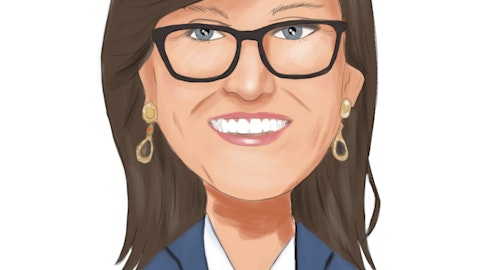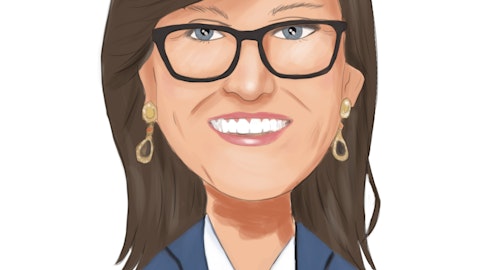Dustin Scaringe: Hi everyone. Good afternoon and thanks for taking our questions. First here on nasal swab, you guys published validation data in December. Just wondering if you could talk about the feedback you’ve received on that since publication? And then as a follow-up to that how are you thinking about the TAM here? And given this was validated on individuals that had some sort of smoking history?
Marc Stapley: Yes. Great questions. So, the data that we ended up publishing or getting published in CHEST in December is data which had previously actually a couple of years ago. So getting into a final publication I think is an outstanding outcome. And I congratulate our entire team and others that we worked with on that publication. And it’s great to finally see it out there. In terms of level of interest, I think that publication really does a couple of things for us. One is it helps us to really commence those reimbursement conversations and start to get ahead of that. We now have a peer-review publication in hand to do that. It also helps us have conversations with potential partners and others who might want to do some work with nasal swab in the future.
So, very excited about that. But really where I had kind of hang my greatest sense of — the level of interest in nasal swab so far is in NIGHTINGALE because as I mentioned on the call we are close to 100 sites enrolling. The level of interest in those sites, so if you think about what it takes from a clinical operations standpoint to identify gain interest from contracts sign up initiate and then commence enrolling a nearly 100 sites, it’s significant. And it can only come from those investigators and those institutions being excited about the prospect of the test itself and being a part of that clinical utility study. So that to me I think is so far of one of our greatest indicators of interest in nasal swab and we’re excited to see how that goes and certainly have a desire to see the clinical utility come out of that study.
Dustin Scaringe: Understood. Just staying on that topic.
Marc Stapley: So, yeah – I am sorry, you did asked – I am sorry, you asked about the market size the TAM and smoking history.
Dustin Scaringe: Yes.
Marc Stapley: I should cover that. Yes just to come to be very clear. I mean nasal swab is based on smoking patients who have a smoking history and it really measures the damage to the epithelial airway. One of one cause of that damage is of course smoking. ACE to expand the TAM beyond that would require a study that includes non-smokers and that is not the biggest market we’re looking at. By far the largest market is those patients who are eligible for lung cancer screening and those who have lung nodules incidentally found which are 15 million and 1.6 million, respectively. That by far is the biggest market. And a significant proportion of those are current or former smokers and would fit the eligibility criteria for nasal swab.
A next step in the future could very well be trying to expand that TAM by doing the necessary studies you know outside of non-smoking. We just don’t know whether that figure until you’ve done the study. You don’t know whether that strategy produces the same results or not. But by far we focused the product initially on the largest proportion of the market.
Dustin Scaringe: Understood. Thank you for that. And switching over to Afirma. Just wondering if we should be thinking about any reimbursement dynamics for that test in 2024? And then any considerations longer-term about pricing for this product? Thank you.
Rebecca Chambers: Yes, I’m happy to take that. And so Afirma I mean if you rewind the clock back to 2021 with the code change on we did see the impact in 2022 of that. And then over the course of 2023 we did see obviously the benefit of resolution of many of those the impact of 2021 and 2022 tied to the code change. And so the reason why I go back throughout all of that history is you know the ASP for Afirma at this point in time based on those resolutions is quite elevated. And so I think when it comes down to it today we’re in a great position. Our goal is to maintain that position we see no reason why we can’t continue to do so. We had some smaller managed care wins over the course of the back half of last year that really that really help us help us be confident that we’ll be able to maintain ASP plus or minus a bit as we see any given quarter.
So I think on the Afirma side not any big on — not any big dynamics to think through from a payment reset perspective that doesn’t come to bear until 2028 as well. So we feel great about the work the team has done both on the managed care and the billing side and collection side. And I think we’re going to be obviously quite focused about that going forward. Over the course of I think also it’s worth highlighting on the Decipher side, obviously less of a dynamic with a code change like we had on Afirma, but I think a different portion of the story given it’s more nascent in its coverage and contract contracted lives. And so we do have a very good story on the on the Decipher ASP. We’ve gotten a number of wins over the course of 2023 and we’re hopeful we’ll have some more over the course of 2024 and 2025 and so on we’re obviously we’re obviously hoping that we can continue to progress the coverage for Decipher given effectively the level one status that it has in the publication and clinical support of ours.
Dustin Scaringe: Appreciate all the color there . Thank you.
Operator: Thank you. One moment for our next question. Comes from the line of Matt Sykes with Goldman Sachs. Please proceed.
Matt Sykes: Hey, guys congrats on the quarter. Thanks for taking the question. Is there any way to quantify how much benefit you see from your established commercial infrastructure with Decipher prostrate and how much can be applied in your bladder MRD test?
Marc Stapley: Yes it’s a great question. I mean the urology the leverage that we’re getting out of our urology sales force in prostate alone has been very significant. And I think you see that in the numbers. We added less than a handful of net total reps in last year. And you can see the significant growth that we got out of Decipher. One of the reasons, we think there’s a lot of reasons why we actually think an MRD based test in bladder is the right test for us not to mention the cohort that we’ve got the work that’s been done already, but really importantly is leveraging that urology sales force again and it goes back to the comments we made. And I think it was in response to the first question. The benefit of having more and more menu available for our reps as they go out and they got this fantastic relationships with the urologists from large group practices all the way down to the community being able to offer the patients who are dealing with bladder cancer, which is a terrible prognosis in many cases and having something to offer and to enable to determine whether or not their treatment has been and has been, or is being effective, it will be incredibly meaningful.
So we do think we’ll be able to leverage the existing sales force that we have and will have at that time without having to grow it substantially, while it might be within a practice that might be though a dozen urologists and maybe one of them specializes in bladder cancer. And so you might you might find that it’s a different sell. It’s a different product sold to a specific specialty within their practice. The reality is we have incredible access to those practices in general. And so we don’t anticipate a great deal of extra investment required in order to sell our test in total.
Rebecca Chambers: Agreed. And I would just add one more thing on, obviously, the Decipher franchise extends into the revenue cycle management and client services piece and all the infrastructure to order the test arm, which has been obviously now invested in and we will sustain and also benefit from office staff using historically on that but should also help the commercial efforts on the MRD side, the knowledge and awareness of those types of interactions.
Matt Sykes: Got it. Thanks. That’s really helpful color. I know we touched on earlier, but this is helpful. And then how durable do you see Afirma as once thyroid cancer diagnostic TAM has reached that 80% penetration, and do you have a specific time line to that penetration, Mark?
Marc Stapley: We don’t have a timeline, but if you think about it the firm has been on the market for more than a dozen years at this point. And it’s taken about for that long to get to the penetration that we’ve currently got with an 80% estimate out there is multiple years of growth still left in Afirma just to target the conditions that we currently cover and the indications that we currently have. And so we as you know we’ve been investing heavily in Afirma. We invested in tests. As we talked about during this call we invested in the physician ordering of experience and portal. We just launched the Afirma GRID. And so time after time, we’re creating new opportunities to engage with physicians and convince even more of them to use Afirma more often in more cases, and so we’re gaining wins in terms of both existing accounts and new accounts.
And so yeah it’s hard to put a timeframe on when that plateaus as everything eventually always does but it’s clear that we’ve got a lot of fairly decent amount of headroom still to go even in endocrinology.
Matt Sykes: Got it. Thank you.
Operator: Thank you. One moment for our next question. And it’s from the line of Mike Matson with Needham. Please proceed.
Unidentified Analyst: Hey, everyone. This is Joseph [ph] on for Mike. I guess just looking at other kit development you obviously, you guys have a lot on your hands Envisia and Decipher in on [indiscernible]. but just maybe wanted to ask question more broadly if there’s any other disease areas you guys are focusing on for future test development, or I guess that it’s more focusing on MRD versus DI diagnostic in our assay. And just kind of wanted to get your thoughts on that?
Marc Stapley: Yeah, it’s a great question. As you think about it Veracyte has really come from that single product, Afirma company to a broad cancer diagnostic company and now with the addition of MRD, we can go even further. If you think about the growth vectors that we’ve talked about. I’ll start with geographical on it. So the success that we’ve had in the US with our launch of our IVD products outside the US and a clear road map of what really amounts to three or four products that we’re going to launch over the next few years there. You can see that we’ve got a real opportunity to grow outside the US and really demonstrate that the model that we’ve adopted works than there has been so successful for us with the genome. Extensive publications behind our tests can benefit us outside the US as well.
So that’s number one. The second one is across the care continuum. And I wouldn’t say we’re going to focus on any area in particular rather than the entire care continuum for patients who have cancer or suspected of having cancer, all the way from nasal swab, which is focused on those patients who don’t have a cancer diagnosis, but have a lung nodule and therefore our risk and helping to classify those patients almost think of that as like a part of a high-risk screening program, all the way through diagnosis, prognosis, prediction you’re starting to see Decipher move into that prediction space in a very meaningful way, as there are more and more publications the year talk about the virtues and the benefits of using Decipher in that way all the way through to treatment from recurrence and monitoring.
And so yeah, as you think about it that way we are able to cover a very broad part of the care continuum everything but screening for healthy people, if you think about it that way. And then the third dimension is the indications. And yeah, Veracyte has a virally prostate, breast, bladder, lung and now with MRD. you can think about how much more extensible that could also be across other indications. So one of the great benefits of the platform that we’ve got the large amounts of data that we generate on is that we can that is extensible across other indications as well. Of course, there always channel considerations. You have to go through there and think about as well. And we do them well. But you can certainly see there’s opportunities for us to expand beyond the current indications that we have no clarity yet on what those might be.



